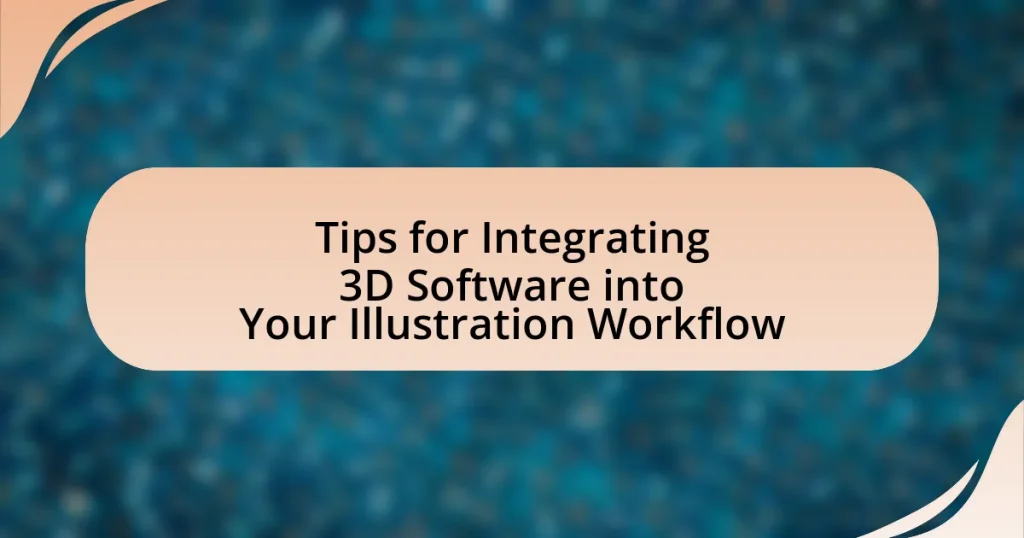The article focuses on integrating 3D software into illustration workflows, highlighting key considerations such as compatibility with existing tools, the learning curve, and project requirements. It discusses how 3D software can enhance traditional illustration techniques by providing realistic lighting, textures, and perspectives, while also addressing challenges illustrators may face, including technical issues and the impact of learning curves. Additionally, the article outlines best practices for incorporating 3D elements, balancing traditional and digital techniques, and maximizing efficiency through effective project organization and resource utilization.

What are the key considerations for integrating 3D software into your illustration workflow?
Key considerations for integrating 3D software into your illustration workflow include compatibility with existing tools, learning curve, and project requirements. Compatibility ensures that the 3D software can seamlessly work with your current illustration tools, which is crucial for maintaining efficiency. The learning curve is significant; understanding the software’s features and functionalities can take time, impacting project timelines. Additionally, project requirements dictate whether 3D integration is necessary, as not all illustrations benefit from 3D elements. For instance, a study by the University of California found that 3D models can enhance visual storytelling in complex illustrations, but may not be suitable for simpler designs.
How can 3D software enhance traditional illustration techniques?
3D software can enhance traditional illustration techniques by providing artists with tools for creating realistic lighting, textures, and perspectives that are difficult to achieve by hand. This software allows illustrators to visualize their concepts in three dimensions, enabling them to experiment with angles and compositions more effectively. For instance, using 3D models can help artists understand spatial relationships and proportions, leading to more accurate and dynamic illustrations. Additionally, 3D software can streamline the workflow by allowing for quick adjustments and iterations, which can save time and improve the overall quality of the final artwork.
What specific features of 3D software are most beneficial for illustrators?
The specific features of 3D software that are most beneficial for illustrators include advanced rendering capabilities, customizable lighting options, and the ability to create and manipulate 3D models. Advanced rendering allows illustrators to produce high-quality images with realistic textures and shadows, enhancing the visual appeal of their work. Customizable lighting options enable artists to simulate various environments and moods, providing greater control over the final output. The ability to create and manipulate 3D models facilitates the exploration of different perspectives and compositions, which can lead to more dynamic illustrations. These features collectively enhance the creative process and improve the overall quality of illustrations.
How does 3D software improve the visualization of complex concepts?
3D software enhances the visualization of complex concepts by providing a multi-dimensional perspective that allows users to manipulate and interact with objects in a virtual space. This capability enables clearer representation of intricate structures, such as anatomical models in medical education or architectural designs in urban planning, facilitating better understanding and retention of information. Studies have shown that visual learning through 3D models can improve comprehension by up to 80% compared to traditional 2D representations, as users can explore and visualize relationships and spatial arrangements more effectively.
What challenges might illustrators face when incorporating 3D software?
Illustrators may face several challenges when incorporating 3D software, including a steep learning curve and integration issues with traditional techniques. The complexity of 3D software often requires significant time investment to master, which can disrupt an illustrator’s workflow. Additionally, compatibility problems may arise when trying to merge 3D models with 2D illustrations, leading to inconsistencies in style and quality. These challenges can hinder productivity and creativity, making it essential for illustrators to develop strategies for effective integration.
How can learning curves impact the integration process?
Learning curves significantly impact the integration process by influencing the speed and efficiency with which users adopt new 3D software. A steep learning curve can lead to prolonged adaptation periods, causing delays in workflow and potential frustration among users. Conversely, a gentle learning curve facilitates quicker mastery of the software, enabling users to integrate it into their illustration workflow more seamlessly. Research indicates that software with intuitive interfaces and comprehensive tutorials can reduce the learning curve, thereby enhancing user satisfaction and productivity. For instance, a study by Nielsen Norman Group highlights that user-friendly design can decrease training time by up to 50%, underscoring the importance of learning curves in successful software integration.
What common technical issues arise when using 3D software with illustration tools?
Common technical issues that arise when using 3D software with illustration tools include compatibility problems, performance lag, and rendering errors. Compatibility issues often occur when file formats between different software do not align, leading to difficulties in importing or exporting assets. Performance lag can result from high polygon counts or complex textures, which may slow down the illustration tools, making the workflow inefficient. Rendering errors can manifest as visual artifacts or incorrect lighting, which can compromise the quality of the final output. These issues are frequently reported by users in forums and technical support discussions, highlighting the need for careful integration strategies.

How can you effectively incorporate 3D software into your existing workflow?
To effectively incorporate 3D software into your existing workflow, begin by identifying specific tasks within your illustration process that can benefit from 3D modeling, such as creating complex backgrounds or character poses. Integrating 3D software can enhance efficiency and accuracy, as it allows for quick adjustments and realistic visualizations. For instance, using software like Blender or SketchUp can streamline the design phase by providing a three-dimensional reference that can be manipulated easily, thus saving time compared to traditional methods. Studies have shown that artists who utilize 3D tools report a 30% increase in productivity, as they can focus more on creative aspects rather than technical details.
What steps should you take to start using 3D software in your illustrations?
To start using 3D software in your illustrations, first select a suitable 3D software program that aligns with your illustration needs, such as Blender, Maya, or Cinema 4D. Next, familiarize yourself with the software through tutorials and documentation, which provide essential skills and techniques for effective use. After gaining foundational knowledge, practice by creating simple 3D models and integrating them into your illustrations to understand how they enhance your work. Finally, experiment with lighting, textures, and rendering settings to achieve the desired visual effects, thereby improving the overall quality of your illustrations.
How do you choose the right 3D software for your illustration needs?
To choose the right 3D software for your illustration needs, assess your specific project requirements, including the desired style, complexity, and output format. Different software excels in various areas; for instance, Blender is known for its versatility and is free, while Autodesk Maya is preferred for character animation due to its robust tools. Additionally, consider the learning curve and community support, as software with extensive tutorials and forums can facilitate quicker mastery. According to a survey by the 3D Artist Magazine, 70% of professionals prioritize software that integrates well with their existing tools, highlighting the importance of compatibility in your decision-making process.
What are the best practices for setting up your workflow with 3D software?
The best practices for setting up your workflow with 3D software include organizing your project files systematically, utilizing templates for consistency, and establishing a clear naming convention for assets. Organizing project files helps in easy navigation and retrieval, which is crucial for efficiency, especially in complex projects. Utilizing templates ensures that all elements adhere to a consistent style and format, reducing the time spent on setup for each new project. A clear naming convention for assets aids in quick identification and collaboration, minimizing confusion during the workflow. These practices enhance productivity and streamline the integration of 3D software into illustration workflows.
How can you balance traditional and digital techniques in your workflow?
To balance traditional and digital techniques in your workflow, integrate both methods by using traditional media for initial sketches and digital tools for refinement and finalization. This approach allows artists to leverage the tactile experience of traditional techniques while benefiting from the precision and versatility of digital software. For instance, artists can create hand-drawn concepts and then scan them into a digital platform like Adobe Photoshop or Procreate, where they can enhance and manipulate their work. This method not only preserves the unique qualities of traditional art but also utilizes the efficiency of digital tools, leading to a more dynamic and flexible workflow.
What strategies can help you maintain your artistic style while using 3D software?
To maintain your artistic style while using 3D software, consistently reference your traditional techniques and visual elements during the 3D modeling process. This approach ensures that the unique characteristics of your style, such as color palettes, textures, and forms, are integrated into the 3D work. For instance, artists often create custom shaders or textures that mimic their traditional media, allowing the 3D output to reflect their original artistic intent. Additionally, regularly comparing your 3D models with your 2D sketches can help you stay aligned with your artistic vision, ensuring that the final product resonates with your established style.
How can you effectively combine 2D and 3D elements in your illustrations?
To effectively combine 2D and 3D elements in your illustrations, utilize layering techniques in digital software to integrate both dimensions seamlessly. This approach allows for the manipulation of 3D models within a 2D space, enhancing depth and perspective. For instance, software like Adobe Photoshop or Procreate enables artists to import 3D objects and adjust their opacity, blending modes, and positioning to create a cohesive visual narrative. Additionally, using shadows and highlights from the 3D elements can enhance the realism of the 2D components, making the overall illustration more dynamic and engaging.

What are some practical tips for maximizing the benefits of 3D software in illustration?
To maximize the benefits of 3D software in illustration, artists should integrate 3D models into their workflow for enhanced perspective and realism. Utilizing 3D software allows for accurate lighting, shadows, and textures, which can significantly improve the overall quality of illustrations. For instance, artists can create complex scenes in 3D and then render them as 2D images, ensuring precise proportions and spatial relationships. Additionally, leveraging features like camera angles and animation tools can help in visualizing dynamic compositions. Studies show that artists who incorporate 3D elements report increased efficiency and creativity, as they can experiment with various designs quickly without starting from scratch.
How can you streamline your workflow with 3D software?
To streamline your workflow with 3D software, utilize efficient modeling techniques and automation tools. Efficient modeling techniques, such as using parametric design and modular components, reduce the time spent on repetitive tasks. Automation tools, like scripts and plugins, can automate routine processes, enhancing productivity. For instance, Blender’s scripting capabilities allow users to create custom tools that can significantly speed up tasks like rendering and animation. By integrating these methods, users can achieve a more efficient workflow, ultimately saving time and resources in their illustration projects.
What tools and plugins can enhance your 3D illustration process?
Blender, ZBrush, and Adobe Dimension are tools that can significantly enhance your 3D illustration process. Blender offers a comprehensive suite for modeling, sculpting, and rendering, making it a versatile choice for artists. ZBrush specializes in high-resolution sculpting and detailing, allowing for intricate designs that can elevate the quality of illustrations. Adobe Dimension simplifies the integration of 3D assets into 2D designs, streamlining the workflow for illustrators who need to combine both dimensions effectively. These tools are widely recognized in the industry for their capabilities and user-friendly interfaces, making them essential for improving the efficiency and quality of 3D illustrations.
How can you organize your projects to improve efficiency?
To improve efficiency in organizing your projects, implement a structured workflow that includes clear milestones, task prioritization, and regular reviews. Establishing a project timeline with specific deadlines helps in tracking progress and maintaining focus. Utilizing project management tools, such as Trello or Asana, allows for better collaboration and visibility among team members. Research indicates that teams using structured project management methodologies can increase productivity by up to 20%, as they reduce time spent on unproductive activities and enhance communication.
What are the best resources for learning and improving your 3D skills?
The best resources for learning and improving your 3D skills include online platforms like Blender Guru, Udemy, and Coursera, which offer structured courses on various 3D software. Blender Guru provides tutorials specifically for Blender, a widely used free 3D software, while Udemy and Coursera host a range of courses covering different aspects of 3D modeling, animation, and rendering across various software like Maya and 3ds Max. Additionally, YouTube channels such as CG Geek and FlippedNormals offer free tutorials and tips from industry professionals, enhancing practical understanding. These resources are validated by their popularity and user reviews, indicating their effectiveness in skill development.
Which online courses or tutorials are recommended for illustrators?
Recommended online courses for illustrators include “Illustration Masterclass” on Skillshare, which covers various techniques and styles, and “Digital Illustration: Learn to Use Procreate” on Udemy, focusing on digital tools. Additionally, “Creating 3D Illustrations in Blender” on Coursera teaches how to integrate 3D software into illustration workflows. These courses are well-reviewed and provide practical skills that enhance an illustrator’s capabilities.
How can community forums and groups support your learning journey?
Community forums and groups can significantly enhance your learning journey by providing access to a wealth of shared knowledge and experiences. These platforms facilitate interaction with peers and experts, allowing for the exchange of tips, techniques, and resources specific to integrating 3D software into illustration workflows. For instance, members often share tutorials, answer questions, and offer feedback on projects, which can accelerate skill development. Research indicates that collaborative learning environments, such as forums, can improve retention rates and understanding of complex subjects, as highlighted in studies by the Journal of Educational Psychology.
What troubleshooting tips can help you overcome common issues with 3D software?
To overcome common issues with 3D software, users should first ensure that their hardware meets the software’s system requirements, as inadequate hardware can lead to performance issues. Additionally, regularly updating the software can resolve bugs and improve functionality. Users should also check for compatibility between the 3D software and any plugins or extensions being used, as conflicts can cause crashes or errors. Clearing the software’s cache and temporary files can help improve performance and resolve unexpected behavior. Lastly, consulting the software’s official documentation or user forums can provide specific solutions to known issues, as many users share their troubleshooting experiences and fixes.
How do you resolve rendering problems in your 3D illustrations?
To resolve rendering problems in 3D illustrations, I first analyze the scene for common issues such as incorrect lighting, material settings, or geometry errors. Adjusting the lighting setup can often eliminate shadows or highlights that cause rendering artifacts. Ensuring that materials are correctly configured, including texture maps and shaders, is crucial for achieving realistic results. Additionally, I check for any non-manifold geometry or overlapping faces, as these can lead to rendering failures.
For instance, using software like Blender or Maya, I utilize built-in diagnostic tools to identify and fix these issues. According to a study published in the Journal of Computer Graphics Techniques, optimizing scene complexity and using appropriate rendering settings can significantly reduce rendering times and improve output quality.
What steps can you take to fix compatibility issues with other software?
To fix compatibility issues with other software, first, ensure that all software applications are updated to their latest versions, as updates often include compatibility fixes. Next, check the system requirements for each software to confirm they align with your hardware and operating system specifications. Additionally, consult the documentation or support forums for both software applications to identify known compatibility issues and recommended solutions. If problems persist, consider using file conversion tools or plugins designed to facilitate interoperability between the software. Finally, testing the workflow with sample projects can help identify specific compatibility issues before full implementation.


